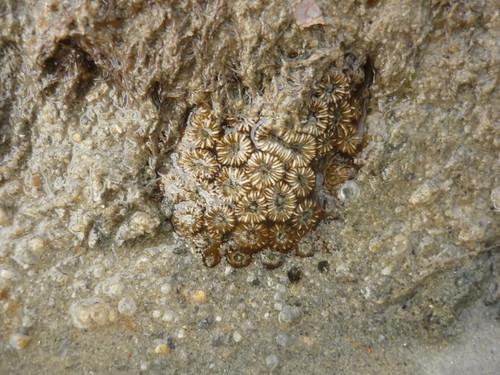
One thing I love about visiting this shore is that I simply don't quite know what to expect. Since this beach is so heavily impacted by surrounding human activities, it's easy to dismiss the waters here as being relatively lifeless compared to other more pristine shores. But it increasingly appears that the murky waters have plenty of secrets to reveal.
This time around, I made extra preparations. After my previous visit, I'd listed a couple of things that I would need:
The next time I visit this shore, I'm definitely going to need the following:
i) Containers. I'm not a fan of taking photos of marine animals in plastic containers, since I greatly prefer showing them in their natural environment. But given the murky water, and the fact that it's too easy for various creatures to swim away into deeper water and vanish, the use of containers will be a great aid.
ii) Nets. A few small aquarium nets, which would help me spend more time studying fish closely, instead of just seeing them shoot off into the depths before I can even react to their presence. Used in conjunction with a few small plastic containers, I don't have to worry so much about all the sediment in the water when I'm trying to take photos.
I have to admit, catching animals, even if it's just to take a few photographs, seems like a cop-out. It's a bit like trapping a lion or bird simply because you're not able to creep close enough to get a good photograph. And I really dislike subjecting the animals to such stress. But the fact that I'd brought plastic containers and two handheld nets really made it so much easier for me to take a closer look at the marine life living in these waters.
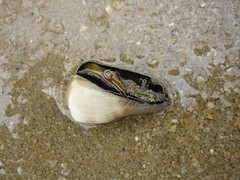

While the black-lipped conch (Canarium urceus) is found in some numbers, especially close to the bridge, I managed to find only a single pearl conch (Laevistrombus canarium).
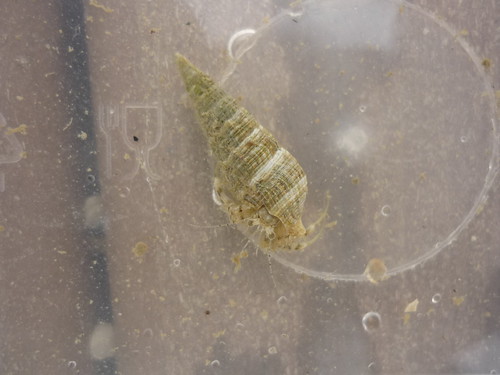
I didn't really bother looking at the creeper snails (F. Cerithiidae and Potamididae), because I wanted to spend more time looking for other less common creatures. Another reason was because every creeper snail I picked up turned out to contain a tidal hermit crab (Diogenes sp.) instead. But based on cursory observation, it would seem that the most common species would be the zoned horn snail (Batillaria zonalis), with smaller numbers of banded creeper snails (?Cerithium sp.) and plain creeper snails (?Cerithium sp.).

Here's a tidal hermit crab that's substantially larger than the others, large enough to occupy the shell of a pearl conch.
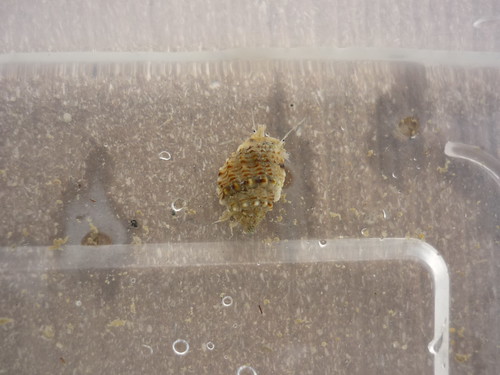
Besides creeper snails, other very common snails on this shore include the whelks. The tiny prickly whelk (Nassarius crenoliratus) is found in large numbers, often half-buried in the sand at the water's edge.
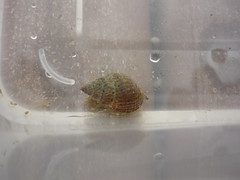
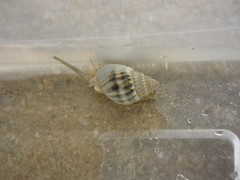
The common whelk (Nassarius livescens) is also well-represented on this shore.

I've found a large spiral melongena (Pugilina cochlidium) on this shore before, but today, I found only two rather small specimens, crawling on the submerged parts of the bridge.
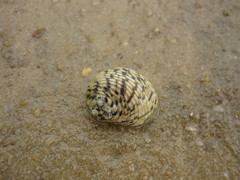
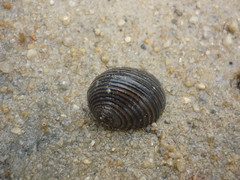
Although I did not see any live nerites today, I did find a couple of empty nerite shells. The one on the left is the waved nerite (Nerita undata). The one on the right though, is very interesting. The lined nerite (Nerita articulata) is most often found in mangroves and monsoon drains, so the presence of such a fresh-looking shell here on Sentosa is intriguing.
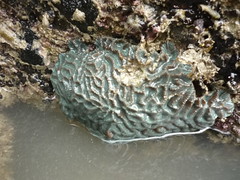
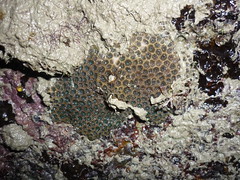
It's nice to see that the small handful of hard corals growing amongst the rocks are still surviving.
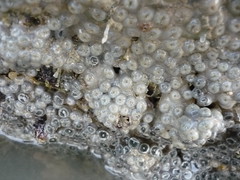
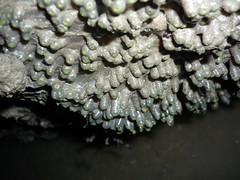
I managed to find two different kinds of zoanthids growing on the rocks, the button zoanthid (Zoanthus sp.) and the broad zoanthid (Palythoa mutuki).
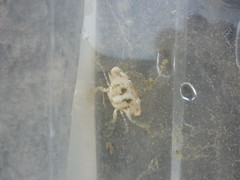

There are numerous tiny swimming crabs (F. Portunidae), and it can be very challenging to spot and capture them. These are possibly very young flower crabs (Portunus pelagicus).
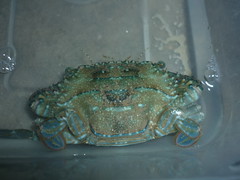
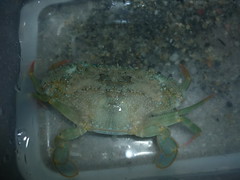
However, there are much larger swimming crabs out there. I did not manage to find any larger flower crabs, but I did find quite a few blue swimming crabs (Thalamita sp.) and blue-spined swimming crabs (Thalamita prymna).
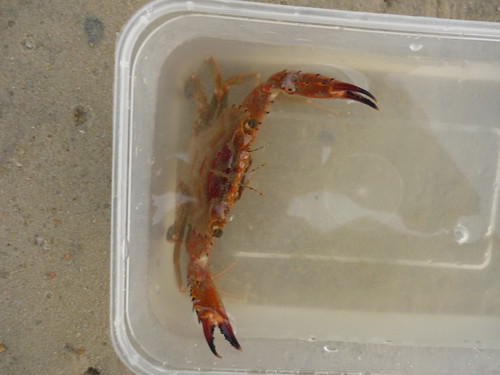
But the most surprising crab find of the day was this red swimming crab (Thalamita spinimana)!
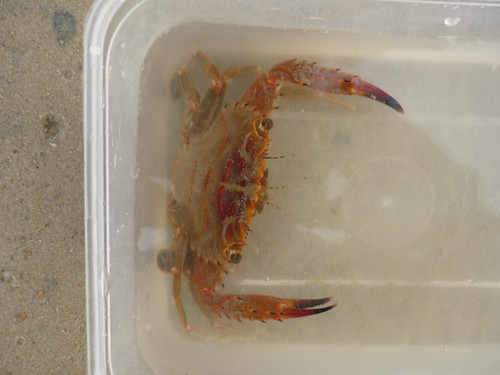
This is the first time I've ever seen this species on Sentosa. This extremely aggressive crab is more often found on reefs in the Southern Islands. Luckily I had the nets with me.
There are numerous shoals of fish, among them Kops' glass perchlet (Ambassis kopsii) and young crescent perch (Terapon jarbua).
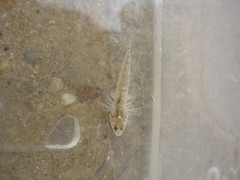
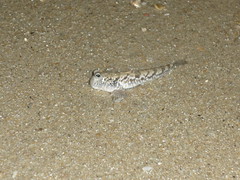
Gobies are also very common here; not only are there small groups of various species resting on the sandy seabed, there are quite a few small mudskippers among the rocks. I think the goby I caught today was a young ornate lagoon goby (Istigobius ornatus), while the mudskipper in my photographs is a gold-spotted mudskipper (Periophthalmus chrysospilos).
A dark wriggling mass in the deeper water catches my eye. To my great surprise, it's a large shoal of baby striped eeltail catfish (Plotosus lineatus)!
They're very skittish, and the water is too murky to take a decent photo of the entire school. I try to slowly herd them towards the shallows, but they simply scatter and merge back into a shoal behind me.
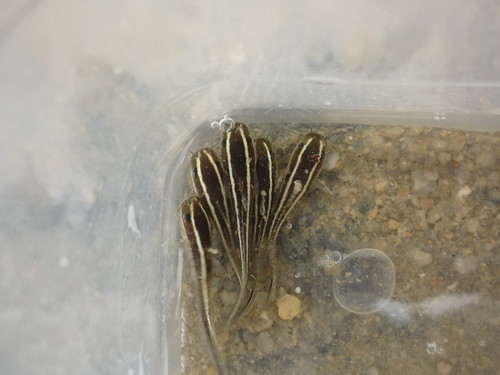
So I sneak up on them, net in hand. More out of sheer luck and the vast numbers of catfish in the shoal, rather than any real skill, I actually manage to net quite a few catfish.
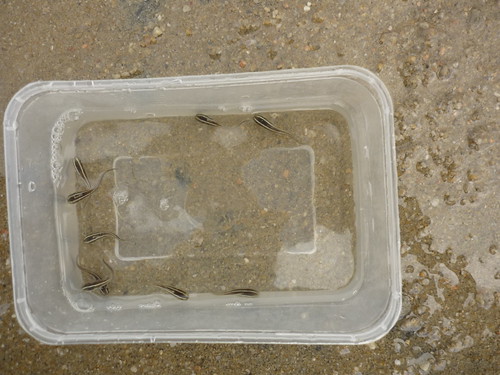
They're so tiny.
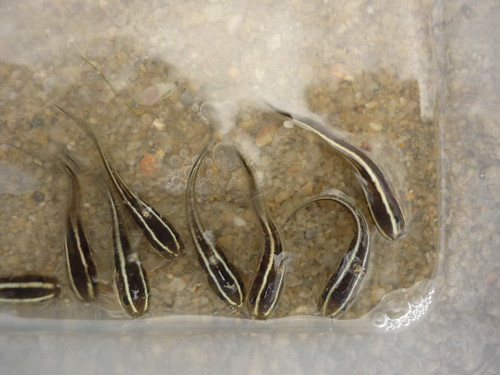
I've seen even larger shoals over at Tanjung Rimau, but this is the first time I've ever seen these catfish in these lagoons.
After releasing the catfish, which promptly vanish into the murky depths, presumably to rejoin the shoal further out in the lagoon, I soon come upon another exciting find: a polyclad flatworm (Pseudobiceros sp.), swimming away.
I took a couple of videos. The background music you can hear in the first clip is coming from the nearby Café del Mar.
Is this the same flatworm I'd seen swimming on one of my previous trips?
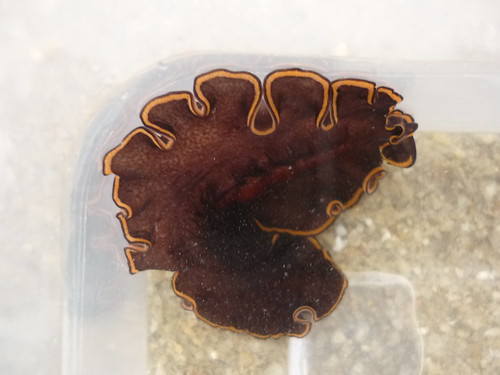
When not swimming, these flatworms crawl about on the seabed in search of food.

EDIT: Initially, I thought that this flatworm might be the orange-edged black flatworm (Pseudobiceros uniarborensis), but there are some subtle differences in this particular worm that lead me to believe that it might belong to another species instead. In fact, it appears to be a species that Ria herself has never seen before!
But this find is quickly overshadowed by another even more unexpected encounter.
I was just walking along the shore, peering into the water, on the lookout for any signs of movement. A piece of seabed stirred, changed colour for a moment, then all but vanished against the sand. It took me a second for my mind to process what I was seeing.
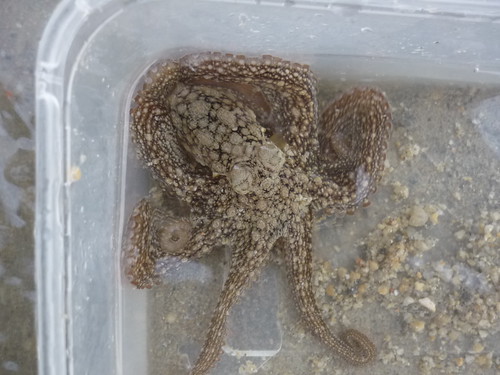
It was an octopus!
Capturing it wasn't easy; the first time I caught it in the net, it released a squirt of ink, and then wriggled its soft body over the edge and fell back into the water. It then held onto a rock and refused to let go. But I finally managed to get it into the net, and got it to remain inside the container for a few minutes while I took as many photos as I could.

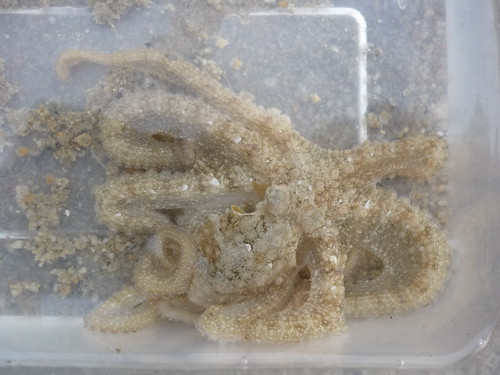
Octopus are supreme masters of camouflage; you can see how this octopus effortlessly changes its colour in an attempt to match the sand. It's likely to be the two-spot reef octopus, which is the species we frequently find at Tanjung Rimau.
Octopus are expert escape artists, as you can see in this video.

I was staring at the sargassum (Sargassum sp.) growing on the bridge when a piece of seaweed moved; it turned out to be an extremely well-camouflaged arrow-head spider crab (Menatheius sp.)
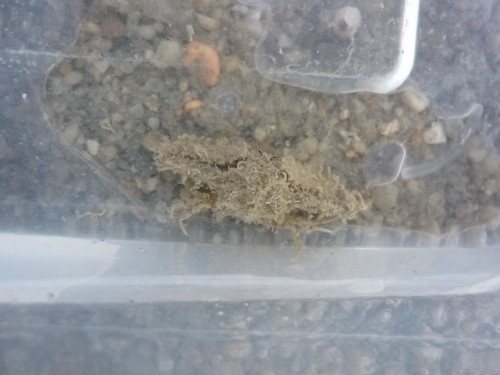
On the other side of the bridge, amongst the spoon seagrass (Halophila ovalis), I find a small elbow crab (F. Parthenopidae).
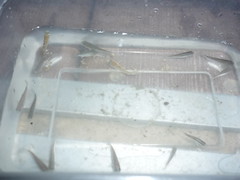
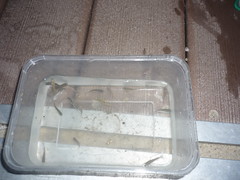
There was a small shoal of fish swimming above the patch of spoon seagrass. Thanks to the tide, taking a closer look at them was simple; all I had to do was place my net in such a way that all of them were swept into it by the waves.

Here's a closer look. I realised that it was a mixed shoal consisting largely of baby mullet (F. Mugilidae), as well as a few Kops' glass perchlet (Ambassis kopsii).
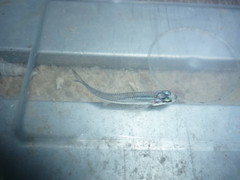
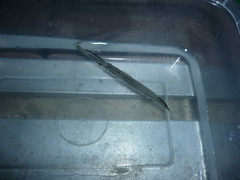
Other fish species in these shallows include tropical silverside (Atherinomorus duodecimalis) and broad-nose halfbeak (F. Hermirhamphidae).

It soon turned out that the octopus was not the only cephalopod inhabiting this lagoon; close to the rocks on one end of the islet, I came upon a pygmy squid (Idiosepius sp.).

As well as a small group of much larger pencil squid (F. Loliginidae). After a few frustrating attempts, I finally managed to get one of them to enter my net. I think these might be bigfin reef squid (Sepioteuthis lessoniana).
The colours of both types of squid look a little washed-out in the photographs, but I think it's partly because of the stress of being caught. In real life, they were both constantly changing colours, thanks to the chromatophores in their skin.

This is a large cirolanid isopod. Like the sea slaters (Ligia sp.) found in rocky shores and mangroves, these critters are scavengers. Burrowing in the sand, they lie in wait at the water's edge, emerging to feast on carrion. This one was much larger than the ones that bit me on a previous trip.
The true highlight of the night came as I was about to head back, contemplating another night without finding the common sea stars (Archaster typicus) that first drew me to this islet 2 years ago. Although I had found a solitary specimen in October, the sea stars were not seen on my most recent visit. So I was a little concerned about their continued presence on this lagoon.
But as I was walking back towards the bridge, something caught my eye. It was the arm of a sea star, poking up from beneath the sand at the water's edge.
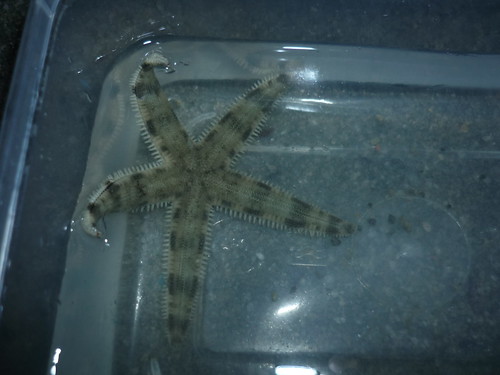
Finally, I'd found my common sea star!
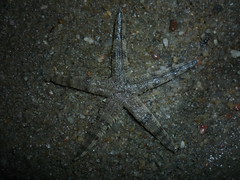
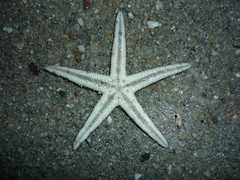
Almost immediately, I spotted a second sea star nearby. Alas, this one was completely unresponsive; it did not try to right itself when flipped over, and the tube feet were not moving at all. I think it was only very recently deceased. The body of a sea star rapidly disintegrate once the animal dies, so those dried sea stars you find as tacky souvenirs and ornaments are actually made by collecting and killing live sea stars.
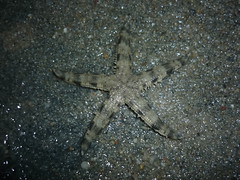
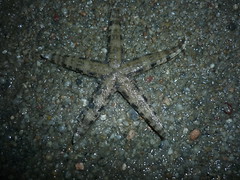
After some very careful and meticulous inspection of the sand, I manage to dig up two more live sea stars.
It's great to see that there's still a small population of common sea stars surviving here after all!
There was so much to see on this trip, and all on a stretch of reclaimed beach only a couple of hundred metres in length. It's a really great example of how marine life can survive in areas of coastal development; it might not be optimal habitat, but as the past few trips have clearly illustrated, it is far from the sterile, lifeless environment that many of us assume it to be.
Striking an odd figure with my aquarium nets and headlamp, crouched over the water, I did attract the attention of quite a few other beachgoers, from little children to couples out to enjoy a romantic evening. Whenever I could, I did share a little about the various creatures I'd found on this shore; at one point, the container full of tiny fish definitely helped to drive home the point that despite all the ongoing development, Siloso Beach is definitely inhabited by a wide variety of marine creatures.
I have to admit that even though the nets and containers were a great help in ensuring that I managed to get decent photographs of the many creatures I spotted, I still prefer to have photographs of the animals taken in situ. And although I did try to release all of the animals as quickly as possible, I do feel a little bad for stressing them out a little, especially with the more high-strung and sensitive organisms such as fish and cephalopods. The octopus and squid were definitely not too pleased about their plight.
Even so, given the extremely murky water and the fine sediment, it would appear that there are few alternatives, short of getting a more powerful camera with underwater capabilities, or actually bringing a small fish tank with me to hold the animals temporarily.
I've also just received a very interesting comment on a post about my previous visit. A reader who goes by the nickname of ahkhee said:
I went to Siloso Beach to free dive a couple of weeks ago during low tide.
I spotted a batfish, some butterflyfish, anemone, pufferfish, purple and orangy sea slugs.
What's interesting is that you can still find some lobster and crab cages at the bottom of the sea bed.
However, it disgusts me to swim in water filled with rubbish. Yet, many fish try to thrive in it.
I am planning on a free diving trip soon. And this time, I am bringing an Underwater camera along.
Perhaps, this time, you can bring ur masks and snorkels and join me in this excavation and discovery.
It's very exciting to hear that! I'm certainly very interested in seeing if ahkhee actually makes the trip, and is subsequently able to tell us what he manages to find. If there are any divers out there willing to join him in exploring such a challenging environment, ahkhee left his email address in his comment. I can't dive, and I have no experience in snorkelling, but I eagerly await future updates if ahkhee goes ahead with his idea.
Siloso Beach has been overlooked by most of us, but as far as I'm concerned, this is one shore that I'll be visiting a lot more often in future.
This is part 2 of a 2-part series on a trip to Siloso Beach on 12th January, 2009.
Part 1: Return to Siloso
Part 2: Siloso: Suckers and Stars (this post)